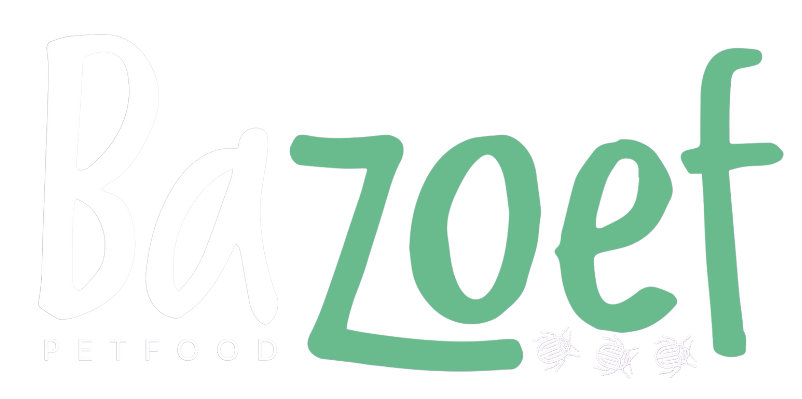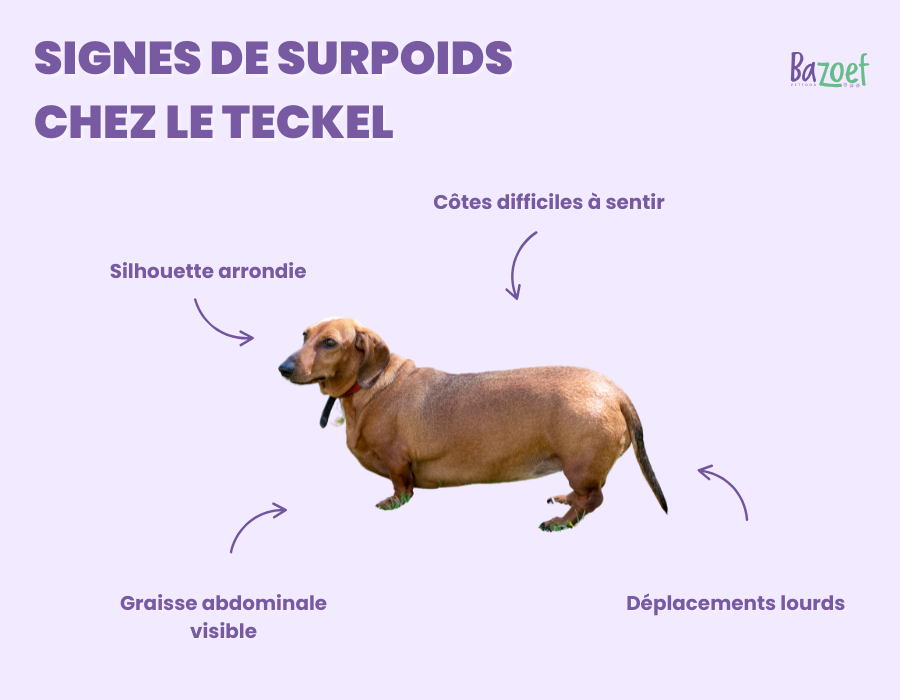With their bright eyes and bold personality, Dachshunds are adored companions — but they’re also one of the breeds most at risk of gaining excess weight.
Their natural tendency to store fat, combined with a big appetite and relatively short legs that limit intense exercise, makes them prone to putting on extra pounds, sometimes even at a young age.
The positive news is that weight gain can be prevented.
By measuring portions carefully, keeping treats to a minimum, and ensuring your Dachshund gets daily activity suited to its build, you can help them stay in good shape.
A balanced diet formulated for their ideal weight, along with regular short walks and play sessions, is often enough to maintain a healthy body and protect their spine.
This guide will explain how.

Is My Dachshund Overweight?
Weight alone doesn’t tell the full story — a Dachshund may look “stocky” because of its long body and short legs, not only because of excess fat.
To properly evaluate your dog’s condition, you need to combine simple visual and hands-on checks you can do at home.
The Body Condition Score (BCS) — a system vets use to assess whether a dog is underweight, overweight, or in ideal shape — is especially useful for Dachshunds. Because extra weight puts severe strain on their spine, maintaining the right condition is critical for preventing back problems.
📊 BCS scale adapted for Dachshunds
| BCS Score | Body Condition | Description for Dachshunds |
| 1–2 | Severely underweight | Ribs and spine very visible, muscle wasting, no fat coverage |
| 3 | Underweight | Ribs clearly visible, pronounced waist, little muscle mass |
| 4–5 ✅ | Ideal weight | Ribs can be felt under a light fat layer, waist visible from above, slight abdominal tuck |
| 6 | Slightly overweight | Ribs harder to feel, waist barely visible, belly starting to round |
| 7 | Overweight | Ribs difficult to feel, body rounded, belly sagging |
| 8 | Significantly overweight | Noticeable fat deposits, no waist, heavy padding around chest or neck |
| 9 | Severely obese | Thick fat deposits, difficulty moving, high risk of back strain and breathing difficulty |
How to Assess Your Dachshund’s BCS at Home
- Feel the ribs: they should be felt under a thin fat layer, not buried under padding.
- Look from above: a slight waist should be visible behind the ribs.
- View from the side: the belly should slope upward toward the hind legs, not hang straight down.
- Check the chest and tail base: there shouldn’t be thick rolls of fat or heavy padding.
👉 A BCS of 4 or 5 is ideal for an adult Dachshund.
At 6, start adjusting food and activity.
At 7 or higher, professional veterinary guidance is strongly recommended.

How Much Should My Dachshund Weigh?
A Dachshund’s weight changes as it grows, then stabilizes once it reaches adulthood.
Because this breed is prone to weight gain — which can put dangerous strain on their back and joints — it’s important to monitor weight from puppyhood.
Regular checks help prevent obesity, which can increase the risk of intervertebral disc disease (IVDD), arthritis, and metabolic conditions.
📊 Guideline table showing average weights for male and female Dachshunds (standard size):
| Age | Average Weight Male | Average Weight Female |
| 2 months | 2.5 – 3.5 kg | 2 – 3 kg |
| 4 months | 4.5 – 6.5 kg | 4 – 6 kg |
| 6 months | 6.5 – 8.5 kg | 6 – 8 kg |
| 9 months | 7.5 – 9.5 kg | 7 – 9 kg |
| 12 months (1 yr) | 8 – 10.5 kg | 7.5 – 9.5 kg |
| 18 months (adult) | 8 – 12 kg | 7.5 – 11 kg |
| Senior (7+ yrs) | Variable (maintain healthy shape) | Variable (maintain healthy shape) |
These numbers are averages. What matters most is your Dachshund’s Body Condition Score (BCS), not just the reading on the scale.
A healthy Dachshund should have a clear waist when viewed from above and ribs that can be felt under a light fat covering.
🔎 Note: These values are only guidelines and can vary depending on a Dachshund’s lineage, activity level, and individual build.
What matters most is your Dachshund’s overall body condition (see “Body Condition Score”), not just the number on the scale.
Tips to Prevent Your Dachshund from Becoming Overweight
1. Adjust portions to their ideal weight
Feed your Dachshund based on their target healthy weight, not their current weight if they’re already overweight.
Always use a kitchen scale to measure food precisely — scoops and cups are often inaccurate and can easily lead to overfeeding.
2. Split meals
Divide the daily ration into two or three smaller meals. This supports digestion, helps reduce begging, and lowers the risk of overeating in one sitting.
Because Dachshunds are prone to gobbling food, using a slow-feeder bowl or hiding kibble in a snuffle mat can encourage slower, calmer eating.
3. Avoid table scraps
Human foods such as bread, cheese, or cured meats are far too rich in fat and salt for Dachshunds.
Even small portions — like a slice of cheese or pizza crust — can equal the caloric load of a full fast-food meal for a human. Avoid feeding from the table to prevent both excess weight gain and bad begging habits.
4. Choose healthy treats
Pick light, low-calorie options like small pieces of carrot, cucumber, zucchini, or apple (without seeds).
Keep treats occasional and always count them as part of your Dachshund’s daily calorie allowance to avoid unintentional weight gain.
5. Keep them active
Dachshunds may be small, but they’re energetic and need daily exercise to stay lean and protect their spine. Aim for two or three short to moderate walks (15–25 minutes each), combined with play sessions at home or in the yard.
Because of their long backs, avoid high-impact activities like jumping on and off furniture. Instead, try puzzle toys, scent games, or gentle training exercises — these burn energy, stimulate the mind, and keep them fit without straining the spine.

Examples of Healthy Foods for Dachshunds
Feeding your Dachshund a balanced diet means choosing ingredients that are digestible, nutrient-rich, and supportive of weight control.
Because this breed is prone to obesity and back problems, foods should promote satiety without excess calories while also supporting joint, coat, and digestive health.
Ingredients like insect protein or pumpkin are especially valuable since they combine digestibility with key nutrients.
📊 Table of healthy food examples for Dachshunds
| Ingredient | Nutritional Benefits |
| Insect protein | Highly digestible, rich in essential amino acids, hypoallergenic, low in fat |
| Hull-less oats | Whole grain, soluble fiber, filling, steady energy release |
| White rice | Easily digestible carbohydrate, gentle on sensitive stomachs |
| Peas | Plant protein and fiber, supports healthy digestion |
| Rapeseed (canola) oil | Balanced omega-3 & 6, supports skin, coat, and cardiovascular health |
| Dried pumpkin | Gentle fiber source, helps with stool regularity and digestion |
| Dried chicory root | Natural prebiotic (inulin), maintains a healthy gut microbiome |
| Brewer’s yeast/extract | Source of B vitamins, enhances coat quality and immune defenses |
| MOS (prebiotics) | Supports gut health, helps control harmful bacteria |
| Dried carrots | High in beta-carotene (vitamin A), natural antioxidant |
| Dried apples | Provides fiber and mild natural sweetness without excess calories |
| Cranberries | Antioxidant-rich, supports urinary health, naturally low in sugar |
A well-balanced Dachshund diet can combine these ingredients in the right proportions to provide complete nutrition — helping them stay lean, strong, and energetic without putting unnecessary stress on their back.
This recipe is especially well-suited for Dachshunds that are overweight or have sensitive digestion, as it limits excess fats, provides filling fibers, and uses highly digestible protein sources to support both weight control and gut health.

It can be served as a complete meal or used as part of a transition toward a more natural or targeted diet (digestive support, weight management, hypoallergenic).
Consequences of Overweight in Dachshunds
Excess weight in Dachshunds is far more than just a cosmetic issue — it can cause serious, long-term health problems that affect both comfort and life expectancy.
Here are the main risks to be aware of:
1. Back and spinal problems
Because of their long spine and short legs, Dachshunds are especially vulnerable to intervertebral disc disease (IVDD).
Carrying extra weight greatly increases the risk of slipped discs, back pain, and even paralysis.
2. Joint and mobility issues
Extra kilos also put stress on the hips, knees, and elbows.
Over time, this can worsen arthritis, patellar luxation, or chronic lameness, making movement painful and reducing activity.
3. Higher metabolic risks
Overweight Dachshunds face a higher risk of diabetes, hypothyroidism, and heart disease.
These conditions often require lifelong treatment and can significantly impact quality of life.
4. Shortened lifespan
Research shows that obese dogs may live up to 2 years less than those at a healthy weight.
For Dachshunds, this means a shorter time with their families and greater day-to-day discomfort.
5. Weakened immune system and inflammation
Excess body fat fuels chronic inflammation, which reduces immune defenses.
This makes Dachshunds more prone to infections, skin problems, and slower recovery from surgery or illness.

Simple Activities to Help Your Dachshund Burn Calories
Dachshunds may be small, but if they don’t get enough activity, they can quickly become sedentary and gain weight.
To prevent obesity (or to support weight loss), it’s essential to provide short, gentle activities that protect their long spine while keeping them engaged.
You don’t need intense workouts — several moderate sessions each day make a real difference.
📊 Table: Fun, calorie-burning activities for Dachshunds
| Activity | Suggested Duration | Benefits |
| Short, brisk walks | 15–25 min, 2×/day | Gentle calorie burn, supports mobility, strengthens bond, safe for spine |
| Indoor play (toys, fetch on floor) | 10–15 min | Light cardio, mental stimulation, safe alternative in poor weather |
| Snuffle mat / scent games | 10 min | Mental enrichment, slows eating, prevents boredom snacking |
| Puzzle toys | 10–15 min | Keeps them busy, burns energy through problem-solving |
| Controlled tug games | 5–10 min | Builds strength, interactive bonding without jumping |
| Training sessions | 5–10 min | Reinforces obedience, stimulates mind and body |
💡 Tip: Avoid activities that involve jumping from heights or frequent stair climbing, as these can strain the spine. Multiple short sessions are safer and more effective than one long, exhausting activity.
Conclusion
Feeding your Dachshund properly is about more than just filling the bowl — it’s a daily investment in their health, mobility, and comfort.
Loving yet prone to weight gain and spinal stress, Dachshunds need a carefully balanced diet, regular weight checks, and gentle daily exercise.
Whether you choose high-quality kibble, a properly formulated homemade plan, or a mixed approach, the keys remain the same: quality, moderation, and consistency.
By monitoring your Dachshund’s weight, appetite, energy, and digestion, you’ll give them the best chance at a long, healthy, and happy life by your side.
And always remember: the ideal diet is the one tailored to your Dachshund’s individual needs — not just what works for other dogs.
Sources
- FEDIAF – European Pet Food Industry Nutritional Guidelines — full guideline for nutritionally balanced pet food in Europe.
- AAFCO – Dog and Cat Food Nutrient Profiles — sets standards for “complete & balanced” pet foods in the US.
- WSAVA – Global Nutrition Toolkit — guidance on selecting pet foods and assessing whether they meet nutrient profile standards.



